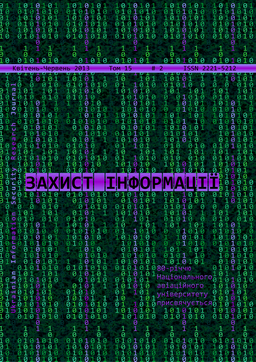The essence of the legal framework and conditions for the provision of trust services in the european union in the period 2015 – 2030 рр.
DOI:
https://doi.org/10.18372/2410-7840.15.4782Keywords:
electronic digital EU market electronic transaction mechanisms for identification, authentication and electronic trust servicesAbstract
The problems of the condition and the need to improve the regulatory and legal legislative base of the European Union (EU) for electronic trust operations in the domestic market are considered. The main provisions of the "Regulations of the European Parliament and the Council for electronic identification and trust services for electronic transactions in the domestic market" are analyzed. The conclusion of the relevance and the need of Ukraine's accession to the electronic digital EU market and related research and development performance are presented. The status of public key infrastructure practice application in European Union and electronic digital signature in Ukraine is analyzed. The basic issues that emerged in the application of electronic digital signature such as unification, standardization, interoperability, scalability, cryptographic stability, complexity of cryptographic transformations are adducted. proposals are developed, and the essence and conditions of the main provisions for the practical implementation of the Regulation, including the future of Ukraine are defined. Requirements that must be addressed in the EU to provide secure electronic services for electronic identification, electronic authentication, electronic signature, electronic seals, electronic time stamps, electronic documents, electronic service delivery and web-site authentication are identified.
References
Горбенко Ю.І., Горбенко І.Д. Інфраструктури відкритих ключів. Системи ЕЦП. Теорія та практика. Харків. Форт. 2010, 593 с.
Горбенко І.Д., Горбенко Ю.І. Прикладна криптологія. Монографія. Харків, ХНУРЕ, Форт, 2012 р., 1 та 2 видання, 878 с.
Директива 1999/93/ЄС Європейського парламенту та Ради від 13 грудня 1999 року про систему електронних підписів, що застосовується в межах Співтовариства
Закон України «Про електронний цифровий підпис». № 852-IX від 22.05.2003
Закон України „Про електронний документ та електронний документообіг”. №851-IV від 22.05.2003.
Закон України "Про захист інформації в інфор-маційно-телекомунікаційних системах". № 2594 – IV від 31.05.2005 р.
Правила посиленої сертифікації, затверджених наказом Департаменту спеціальних телекомунікаційних систем та захисту інформації Служби безпеки України № 3 від 13.01.2005, зареєстрованих в Міністерстві юстиції України 27.01.2005 за № 104/10384 (у редакції наказу Департаменту спеціальних телекомунікаційних систем та захисту інформації Служби безпеки України від 10.05.2006 № 50).
Федеральний закон Российской Федерации «Об электронной цифровой подписи» от 10 января 2002 г.
Столлингс В. Криптография и защита сетей. Принципы и практика. Изд. “Вильямс”. Киев. 2001. 669 с.
The Electronic Signatures in Global and National Commerce Act (ESIGN, Pub.L. 106-229, 14 Stat. 464, enacted June 30, 2000, 15 U.S.C. ch.96. 106th Congress Public Law 229)
Brussels, XXX. COM(2012) 238/2. Proposal for a REGULATION OF THE EUROPEAN PARLIAMENT AND OF THE COUNCIL on electronic identification and trust services for electronic transactions in the internal market (Text with EEA relevance) {SWD(2012) 135} {SWD(2012) 136}.
http://ec.europa.eu/information_society/policy/esignature/eu_legislation/revision
Gorbenko Yu.I., Gorbenko I.D. Public Key Infrastructure. Systems EDS. Theory and Practice. Kharkiv. Fort. 2010, 593 p.
Gorbenko I.D., Gorbenko Yu.I.. Applied Cryptology. Monograph. Kharkiv, KNURE, Fort, 2012, 1st and 2nd edition, 878 p.
Directive 1999/93/EC of the European Parliament and of the Council of 13 December 1999 on the system of electronic signatures used in the Community.
The Law of Ukraine "On electronic digital signature". №852-IX of 22.05.2003.
The Law of Ukraine "On electronic document and electronic documents circulation". № 851-IV of 22.05.2003.
The Law of Ukraine "On Protection of Information in information - telecommunications systems." №2594 - IV of 31.05.2005.
Terms of qualified certification, approved by the Department of Special Telecommunication Systems and Information Protection of Security Service of Ukraine № 3 of 13.01.2005, registered by the Ministry of Justice of Ukraine of 27.01.2005 № 104/10384 (as amended by Order of the Department of Special Telecommunication Systems and Information Protection of Security Service of Ukraine of 10.05.2006 № 50).
Federal law of Russian Federation "On electronic digital signature" of 10 January 2002.
Stallings W. Cryptography and network security. Principles and practices. Pub. "Williams". Kiev. 2001. 669 p.
The Electronic Signatures in Global and National Commerce Act (ESIGN, Pub.L. 106-229, 14 Stat. 464, enacted June 30, 2000, 15 U.S.C. ch.96. 106th Congress Public Law 229).
Brussels, XXX. COM(2012) 238/2. Proposal for a REGULATION OF THE EUROPEAN PARLIAMENT AND OF THE COUNCIL on electronic identification and trust services for electronic transactions in the internal market (Text with EEA relevance) {SWD(2012) 135} {SWD(2012) 136}.
http://ec.europa.eu/information_society/policy/esignature/eu_legislation/revision
Downloads
Published
Issue
Section
License
Authors who publish with this journal agree to the following terms:- Authors retain copyright and grant the journal right of first publication with the work simultaneously licensed under a Creative Commons Attribution License that allows others to share the work with an acknowledgement of the work's authorship and initial publication in this journal.
- Authors are able to enter into separate, additional contractual arrangements for the non-exclusive distribution of the journal's published version of the work (e.g., post it to an institutional repository or publish it in a book), with an acknowledgement of its initial publication in this journal.
- Authors are permitted and encouraged to post their work online (e.g., in institutional repositories or on their website) prior to and during the submission process, as it can lead to productive exchanges, as well as earlier and greater citation of published work (See The Effect of Open Access).

